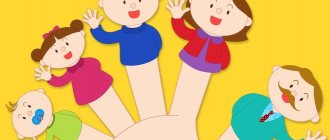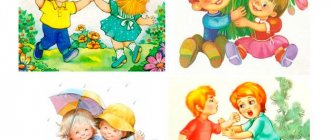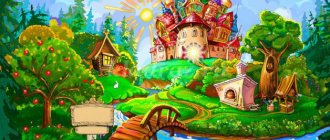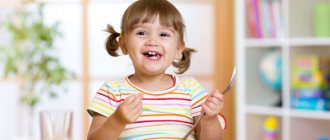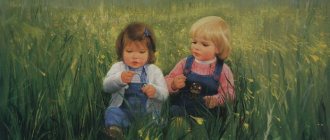Thematic planning “Health Week” in the senior group of preschool educational institutions
Tatyana Ivanova
Thematic planning “Health Week” in the senior group of preschool educational institutions
Thematic planning “Health Week” in the senior group
Goal: Creating conditions for the formation and expansion of children’s knowledge about the components of a healthy lifestyle and the need to take care of their health.
Educational tasks during regime moments:
Conversations "What helps us to be healthy?", "Our faithful friends"
Goal: To develop a conscious attitude towards the need for hardening, to engage in physical exercise and sports, to eat healthy foods, vegetables, and fruits.
Reading: T. Shorygina “Conversations about health” (stories from the manual); S. Marshak “My funny ringing ball”; “Healthy lifestyle” K. Zheleznov; A Tale of Healthy Eating” by V. I. Kovalchuk; “Moidodyr” K. Chukovsky; E. Serova “Little Frog”.
Goal: enrich vocabulary, teach students to listen to reading works carefully, and answer questions.
Finger gymnastics “Athletes”
In order not to be afraid of diseases, you need to play sports: (clench and unclench your fingers)
A tennis player plays tennis, he is an athlete, not an artist (they bend their thumb)
A soccer player plays football (index)
Hockey player playing hockey (average)
Basketball - basketball player (unnamed)
In volleyball - volleyball player (little finger).
Speech development: Looking at the picture “Family doing exercises” and writing a story based on it.
Goal: To help children examine and title the picture, and compose a story based on it.
Drawing:
Topic: “I draw a man”
Goal: to learn to depict a person according to a diagram, emphasizing his body parts, expressively conveying in the drawing the difference in the clothes of a girl and a boy.
Topic: “Drawing according to the idea of “Ball”
Goal: to introduce children to drawing with a simple pencil, filling the entire space of the paper; improve the careful painting of a drawn object with watercolors.
Application:
“Dish with vitamin fruits and berries” - collective composition
Goal: continue to practice techniques for cutting out round and oval-shaped objects, consolidate techniques for neat gluing, and creating a composition.
In order to consolidate knowledge about the components of a healthy lifestyle, at the end of the week a quest game “Journey to the Land of Health” is held.
This game is the author’s development and the final event of the thematic Health Week.
Goals and objectives of the game:
-development of cognitive activity, communicative qualities of children, creative thinking, observation, attention;
- uniting the children's team, developing the ability to work in a team;
- consolidation of knowledge about the components of a healthy lifestyle;
- fostering a caring attitude towards one’s health.
Planning “Health Week” in the first junior group “Health Week” in the first junior group” 06.25. – 06/29/2018 school year d. As part of a thematic week, the first junior group was organized.
Daily comprehensive thematic planning in the junior group of preschool educational institutions (September) No. Integration of educational areas Topic Objectives of the lessons Planned results of the development of integrative qualities Date Note.
Calendar and thematic planning for the summer. Thematic week “Friendship” MONDAY MORNING D/i “Name the family” (word formation) Purpose: to practice word formation; develop attention and speech. Desktop - printed.
Calendar and thematic planning for the summer in the second junior group. Thematic week “Forest birds and animals” MONDAY. 1 pp. Game-exercise “Doll Tanya caught a cold.” Purpose: to show how to properly use a handkerchief. Examination.
Calendar and thematic planning in the second junior group “Ecology Week” Day of the week mode Integration of educational areas Joint activities of adults and children, taking into account the integration of educational areas.
Comprehensive thematic planning “Week of Etiquette and Politeness” in the middle-senior group Date: from 29.10. to 02.11. Topic: Week of Etiquette and Politeness. Objectives: expand children’s understanding of the rules of speech etiquette, stimulate.
MAGAZINE Preschooler.RF
Educational - brain-ring game program “We want to be healthy” (preparatory group B “Stars”) Objectives: Teach children to take care of their health, form healthy lifestyle habits. Develop motor skills, intellectual abilities, analytical thinking. To consolidate children's knowledge about the structure of man, the purpose of the skeleton, joints, the location of the main human organs (brain, heart, lungs, stomach), their purpose and functioning. Leading. Our brain-ring gathered friends: Parents and their children, Friendly guests from all over the world. Are you too lazy to give smiles? So smile every day! Healthy laughter is good for you and saves you from illness. We ask participants to take their seats. The “Knowledgeable” and “Clever” teams with their captains are invited. Let us introduce you to our esteemed jury. Among the jury members there is also Dr. Neboleyka, who wants to see how well the children know their bodies and know how to take care of their health. We start the game by greeting the teams. 1. We are a team - “Knowledgeables”. 2.We are “Smart Guys”, friends. We send greetings to our rivals, There is no way we can lose. And from the bottom of our hearts we wish that we will fight with you, to know the correct answer. We won't give up that easily. Leading. 1st game of “Animation”. — Which organ is called a “perpetual motion machine”? (heart) -Which organ is the most important in the respiratory system? (lungs) - What kind of big “kitchen” is inside us? (stomach) - What helps our body not to look like melted ice cream? (bones). Dear players, now we will ask riddles about human organs. You need to solve riddles, find the desired picture in the envelopes, place the organ on the easel on the image of a person, write a short story about each organ - what it is for and how it works. Puzzles. 1. He is the most important - as a commander. He gives orders, We carry them out immediately. (BRAIN) 2. Everyone lives inside a large kitchen. He doesn’t get tired of working during the day. Gives us strength when he chews something useful. (STOMACH) 3.Two balls are hidden nearby. When they are healthy, we can breathe easily. (LUNGS) “So that the lungs don’t hurt.” Team captains, in front of you are envelopes with the appropriate inscription. The players’ task is to voice each card from the envelope, starting with the words “so that your lungs don’t hurt.” 4. It knocks day and night, as if it was wound up. It will be bad if suddenly this knocking stops. (HEART) What object can you listen to the heartbeat? (phonendoscope). 2nd game. What helps us move. You did a very good job. But the man has not yet come to life, he cannot move. Why do you think? (it has no bones) Questions about the skeleton skeleton. 1.What parts does our skeleton consist of? 2.What connects the bones to each other? 3.Which bones protect our main organs? 4.What is nutrition for our bones? Now the man has come to life and he needs to move. 3rd game. Musical pause. Rhythmic gymnastics. 4th game. Proverbs about health; word to parents. You need to say the proverb and explain it to the children. You guys, listen to your parents. 1. If you don’t forget about the porridge, you will be healthy. 2. A little of the good stuff, not enough of the sweet stuff. 5th game “Exactly right.” Guys, the proverbs were about proper nutrition, which brings only benefits to our body. Do you agree? Let's test your knowledge about proper nutrition. If I talk about healthy things, answer “absolutely true.” And if you talk about something that is harmful to health, you remain silent. - If you want to be slim, you must love sweets. Eat candy, chew toffee, become built like a cypress. -To eat properly, you will remember the advice: Eat fruits, porridge with butter, Fish, honey and vinaigrette. -Don’t forget to have a snack before lunch. Eat a lot to load up your stomach more. - Our love ate buns and became terribly fat. He wants to come visit us, but he can’t crawl through the door. Leading. 6th game “Who can cook soup and compote faster” - relay race. Equipment. 2 hoops, 2 pots, 2 ladle, dummies of vegetables and fruits. Each player takes the necessary ingredients (vegetables) from a set of dummies and transfers them to the pan. The last player takes a ladle, runs up to the pan and stirs the vegetables. The first team to complete the task wins. Surprise moment. Neboleyka thanks the guys. And now, guys, guess my riddle: We all want to be healthy, and for this we need a set of useful... vitamins. That's right, everyone needs vitamins. And in this box I brought you vitamins. (GIVES A TREAT). -If you want to be healthy, eat right, eat more vitamins and don’t know about diseases! Leading. This concludes our brain ring, we would like to thank the participants. The floor is given to the distinguished jury. Educator: Zinchenko O.S.Educational and game program “What we are made of”
(preparatory group B “Stars”) Teacher Zinchenko O.S.
| 1st half of the day. | 2nd half of the day. | |
| Monday | — Social and moral education. Communication “Daily routine”. Goal: to form an idea of the correct adherence to the daily routine and its health benefits (Avdeeva N.N. Safety p. 106) — Examination of illustrations “Human Organs” (didactic material “Human World”): to give an idea of the location of human organs, to develop curiosity. — Psycho-gymnastics “Water Games” (p/p p. 217) Lesson 1. Valueology. introduce children to the purpose of muscles, bones, joints, their role in the human structure, and the possibilities of movement of various parts of the body (N.N. Avdeeva Safety, p. 93). Lesson 2. The world of art. Modeling. "Human" Target: consolidate children’s ability to depict a human figure in sculpting; learn to depict a person in motion. Lesson 3. Physical development. - Walk. Exercises to strengthen posture “River, shore, sail” (M.Yu. Kartushina, p. 191). | — Physical education and health activities: Back massage (M.Yu.Kartushina, p. 55). Awakening gymnastics “Walk in the forest” (see appendix “Folder on health activities”). — Role-playing game "Polyclinic". Goal: to develop the ability to creatively reproduce the plot of the game; consolidate knowledge about the activities of medical personnel; to cultivate respect for the medical profession (N.V. Krasnoshchekova, p. 150). — Walk. A set of general developmental exercises (Kartushina M.Yu. p. 15) |
| Tuesday | — Educational conversation “Our perpetual motion machine” Target: introduce children to the purpose and work of the heart (N.N. Avdeeva, p. 86). — Etude on the development of the emotional sphere “In the forest” (p/p p. 224). Classes according to plan. - Walk. Exercises to strengthen and develop the heart “Ball”, “Swing”, “Frightened Horses” (Kartushina M. Yu. p. 316) | —Physical education and health work: chest massage (“Folder on health activities”): learn how to do massage, which has a beneficial effect on the functioning of the heart. Walking barefoot on massage mats: clarify children's knowledge about the beneficial effects of foot massage on the general condition of the body. — Game – experimentation “Count your pulse”. Target: learn to find the pulse, determine the effect of physical activity on the heart rate (Ivanova A.I. p. 102). — Relaxation “We have a good rest” : Give the idea that a little rest is beneficial for the healthy functioning of the heart. - Lesson according to plan. - Walk. Exercises to develop movement (Kartushina M.Yu. p. 144) |
| Wednesday | — Educational conversation “How we breathe” Target: introduce children to the respiratory organs, their location and functioning (N.N. Avdeeva, p. 90, M.Yu. Kartushina, p. 241) — Psychomuscular training with focusing on breathing “On the Seashore” (plan/program, p. 218). Classes according to plan. - Walk. Exercises to develop breathing (M.Yu. Kartushina, p. 42) | — Physical education and health work: chest massage (“Folder on health activities”): learn how to do massage, which has a beneficial effect on the functioning of the heart and lungs. Awakening gymnastics (see appendix “Folder on health work”). — Familiarization with fiction. Making riddles about food, determining their health benefits (Avdeeva N.N. p. 105, Kartushina M.Yu. p. 274) — Individual work on speech development: compiling a short story on the topic “What we are made of” based on a model of the human structure (“Human World”). Goal: to consolidate knowledge about the functioning of the heart and lungs, to develop coherent speech when composing a descriptive story. — Walk. Gymnastics to calm breathing (Kartushina M. Yu. p. 27) |
| Thursday | — Word game “Exactly true” (Kartushina M, Yu., p. 306): teach children to consciously approach their diet — Looking at illustrations about the structure of the digestive system: develop curiosity, give an idea of the location of the organs of the digestive system (“Human World”). Lesson 1 . Speech development (according to plan) Lesson 2. Natural world. “Why does a person need a stomach?” (Voronkevich O.A. p. 190) Target: form an idea of the digestive organs; reveal the functions and importance of the stomach for the body; cultivate a careful attitude towards your health. — Walk. Individual work on the development of movement: a set of developmental exercises “Vegetable Argument” (Kartushina M.Yu, p. 145): develop motor activity, consolidate knowledge about foods that are beneficial to the body. | — Physical education and health work: abdominal massage (“Health Work Folder”): consolidate the skill of self-massage, which has a beneficial effect on the digestive system. Awakening gymnastics (see appendix “Folder on health work”). — Experimental activity. "How We Breathe" (Kartushina M, Yu. p. 241). Target: use an example to demonstrate the importance of the work of the lungs, show what is released when exhaling; introduce children to a phonendoscope and teach them to listen to the lungs with it. — Walk. P/i “Who can cook the soup faster” (Kartushina M.Yu. p. 146): develop dexterity, speed of movement; consolidate knowledge about useful products. |
| Friday | — Social and moral education. Communication “How to strengthen your bones and muscles Target: consolidate previously acquired knowledge about the human structure, methods of strengthening bones and muscles; develop analytical thinking and the ability to draw conclusions. — Classes according to plan. -Walk. General developmental exercises to strengthen and heal the body (Kartushina M.Yu. p. 180). | — Physical education and health work: Awakening gymnastics “Walk in the forest” (see appendix “Folder on health activities”). Walking barefoot on massage mats. Cognitive and gaming activity “Brain Ring” |
| < Previous | Next > |
